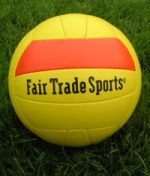The following post is from guest sports blogger Scott James, founder of Fair Trade Sports.
 Here’s a quick primer on sports balls, the materials of which they are made, and their environmental impact.
Here’s a quick primer on sports balls, the materials of which they are made, and their environmental impact.
Sports balls consist of three main components:
- the outer shell (synthetic leather — about 30 percent of the total ball);
- the inner air bladder (rubber — about 70 percent of the total ball); and
- the dyes (less than 1 percent of the total ball).
The vast majority of outer shells are “synthetic leather” — also noted as “PU” (petroleum) or polyester.
Bad news: This portion of the ball is a losing battle. Hardly anyone makes any true leather sports balls anymore. If they did, we could pursue a “cruelty-free” certification process and work to minimize the environmental impact related to animals, child labor in tanning, chrome use in tanning, etc.
Good news: This only accounts for 30 percent of the overall component weight for a typical sports ball.
True leather balls are made, but if uncoated they are unsuitable due to water retention. For instance, for soccer the ruling body (FIFA) requires that the ball weigh about 420 grams, and a wet leather ball is easily double that. If the leather is coated, you are back to dealing with a synthetic product. There are one or two projects in Africa where true leather balls do make sense, because the leather is better able to deal with rough terrain and thorns, and do not have to face much rain.
About 300 grams out of the typical full-size soccer ball is rubber. And that’s a good thing when considering the environmental impact! Rubber is used both for the bladder (cheaper balls use artificial rubber, or butyl) and for laminating the polyester plys onto the outer shell. At Fair Trade Sports, we use butyl only for the little nozzle portion of the bladder — where you insert the inflation needle.
Our international group is pursuing Forest Stewardship Council (FSC) certification for the rubber portion of the sports balls. If successful, we will have FSC-certified balls by early next year. After we solve the FSC rubber project, we’ll move on to work on other related environmental-impact issues with sports ball creation.
 Here's a quick primer on sports balls, the materials of which they are made, and their environmental impact.
Here's a quick primer on sports balls, the materials of which they are made, and their environmental impact.